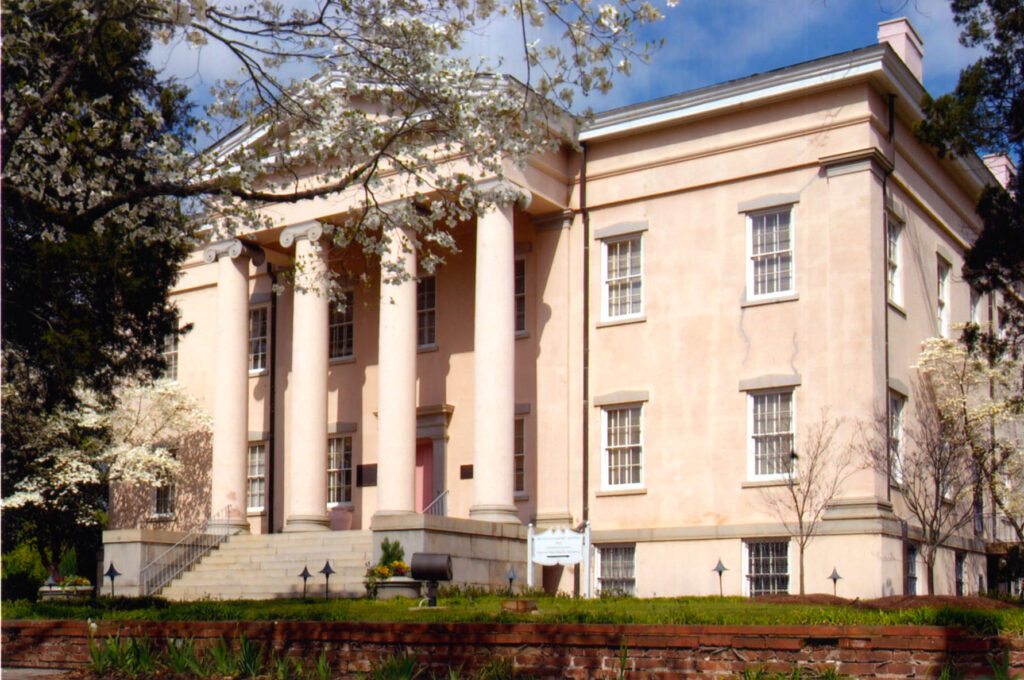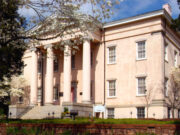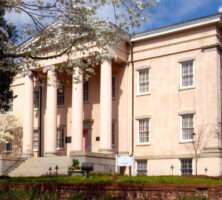The Old Governor’s Mansion is located in Milledgeville, the state’s capital from 1807 to 1868. In 1835 the Georgia legislature resolved to construct the first official residence for the governor. Construction on the Old Governor’s Mansion began in 1836 and was completed in 1838 or 1839. The mansion, designed by the Irish architect Charles B. Cluskey, was erected in the Greek revival style, one of the most significant architectural styles from the early Victorian period of architecture in America. It is considered one of the finest examples of that style in the nation. The building, a three-story stucco-over-brick structure, features a central rotunda and a massive Ionic portico. The supervising builder was Timothy Porter of Farmington, Connecticut.

Courtesy of Georgia College and State University
The mansion served as the home of ten governors and their families, until the removal of the capital to Atlanta in 1868. Governor George R. Gilmer was the first to occupy the house, in 1839, near the end of his second term. Two of the more notable governors were Howell Cobb (1851-53) and Joseph E. Brown (1857-65). Other governors who resided there were Charles McDonald (1839-43), George W. Crawford (1843-47), George W. Towns (1847-51), Herschel Johnson (1853-57), Provisional Governor James Johnson (June-November 1865), Charles Jones Jenkins (1865-68), and Provisional Governor General Thomas Ruger (January-July 1868).
Governor Cobb, who was instrumental in the passage of the Compromise of 1850, also served as President James Buchanan’s secretary of the treasury. Governor Brown resided in the mansion longer than any other governor. His four consecutive terms spanned the end of the antebellum period, the Civil War (1861-65), and the beginning of Reconstruction. The house also hosted such national and international dignitaries as the Whig Party leader Henry Clay and the noted English geologist Sir Charles Lyell. The mansion was the seat of executive power during several turbulent periods in Georgia history, from the removal of the Cherokees in the 1830s to the Civil War in the 1860s.
During the Civil War the mansion became the stage for celebrations, speeches by Confederate generals, and Governor Brown’s efforts to secure Georgia’s autonomy while a part of the Confederate States of America. In November 1864 Union general William T. Sherman and around 30,000 troops marched into Milledgeville. During his brief stay, Sherman was based at the mansion before continuing his march to the sea.
With the removal of the capital in 1868, the mansion was virtually abandoned to state-appointed caretakers. When Middle Georgia Military and Agricultural College (later Georgia Military College) was chartered in 1879, the building was converted into a barracks for the institution’s cadets. In 1891 it became the home of the president of the new Georgia Normal and Industrial College (later Georgia College and State University). The structure served as the home of each successive college president until 1987. The building is the oldest structure on the university’s campus.
In 1973 the Old Governor’s Mansion was designated a National Historic Landmark by the Trust for Historic Preservation; it underwent major renovations in the early 2000s and now serves as a historic house museum open for public tours.






